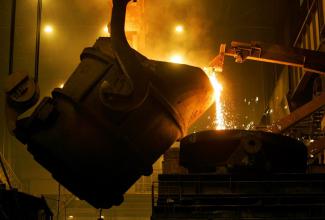NETL and United States Steel Corporation plan to test an advanced membrane technology to capture carbon dioxide (CO2) emissions generated by steelmaking operations at the Company’s Edgar Thomson Plant, located in Braddock, Pennsylvania.
The project is part of the U.S. Department of Energy (DOE)/NETL Point Source Carbon Capture Program. Point source carbon capture from industrial facilities, such as iron and steel manufacturing plants, is a vital element to reduce CO2 emissions and meet the nation’s goals to address climate change.
Carbon capture has the potential to reduce CO2 emissions from blast furnaces. “That makes point source carbon capture at iron and steel plants a priority. The testing of this promising NETL-developed membrane at the Edgar Thomson Plant is an important step to move this groundbreaking technology closer to commercial deployment,” said NETL’s David Hopkinson, technical portfolio lead for Point Source Carbon Capture.
“This is an opportunity to play a role in shaping the future of greenhouse gas reduction for the entire steel industry. Our collaboration with NETL marks a great step forward in U. S. Steel’s ambition to achieving net-zero by 2050,” said Scott D. Buckiso, senior vice president and chief manufacturing officer, North American Flat-Rolled Segment. “Meeting our net-zero goal will take innovation, and our Edgar Thomson plant in the Mon Valley will play a significant role in exploring this crucial technology.”
Compared to other separation technologies, such as solvents and sorbents, polymer membranes offer a comparatively simple CO2 separation process. Membranes require few moving parts and no CO2 regeneration step, resulting in potential cost savings. Additionally, the simplicity of membrane-based processes offers the advantage of reduced capital and maintenance costs.
Membrane-based carbon capture uses permeable materials that allow for the selective separation of CO2 from flue gas. “Using our technology, we hope to generate a high-purity CO2 with a low percentage of nitrogen from flue gas so it can be safely and permanently stored in deep geologic formations or used as a feedstock to manufacture valuable fuels and chemicals and for other productive purposes,” Hopkinson said.
Lab-scale tests of the membrane were completed recently at DOE’s National Carbon Capture Center (NCCC) in Wilsonville, Alabama, which is used to evaluate cost-competitive carbon capture technologies for power plants. Based on the positive results from the NCCC testing, the expanded field test will be undertaken at the Edgar Thomson Plant and seek to separate CO2 from greater volumes of flue gas.
Currently, the design of the test unit to conduct gas separation measurements on the membrane is underway at NETL. In addition, a polymer membrane casting machine has been installed at NETL to allow for the production of larger membrane sheets as the technology is scaled up from lab scale to pilot scale.
“This project sets the stage for the development of membrane technology that can be used at steel mills, cement kilns and other industrial sites that generate significant volumes of greenhouse gas (GHG),” Hopkinson said.
The unit is scheduled to be installed at the Edgar Thomson Plant, part of the U. S. Steel Mon Valley Works, in early 2025. The field test will run for approximately six months.
Project funding was allocated by the DOE/NETL Point Source Carbon Capture Program to develop the next generation of advanced CO2 capture concepts to support the United States in achieving ambitious goals for a GHG-neutral economy by 2050, a carbon-pollution-free power sector by 2035 and a 50% reduction from 2005 levels in economy-wide net GHG pollution by 2030.
About NETL
NETL is a U.S. Department of Energy national laboratory that drives innovation and delivers technological solutions for an environmentally sustainable and prosperous energy future. By leveraging its world-class talent and research facilities, NETL is ensuring affordable, abundant and reliable energy that drives a robust economy and national security, while developing technologies to manage carbon across the full life cycle, enabling environmental sustainability for all Americans.
About U. S. Steel
Founded in 1901, United States Steel is a leading steel producer. With an unwavering focus on safety, the Company’s customer-centric Best for All® strategy is advancing a more secure, sustainable future for U. S. Steel and its stakeholders. With a renewed emphasis on innovation, U. S. Steel serves the automotive, construction, appliance, energy, containers, and packaging industries with high value-added steel products such as U. S. Steel’s proprietary XG3™ advanced high-strength steel. The Company also maintains competitively advantaged iron ore production and has an annual raw steelmaking capability of 22.4 million net tons. U. S. Steel is headquartered in Pittsburgh, Pennsylvania, with world-class operations across the United States and in Central Europe. For more information, please visit www.ussteel.com.
Photo provided by U. S. Steel.




